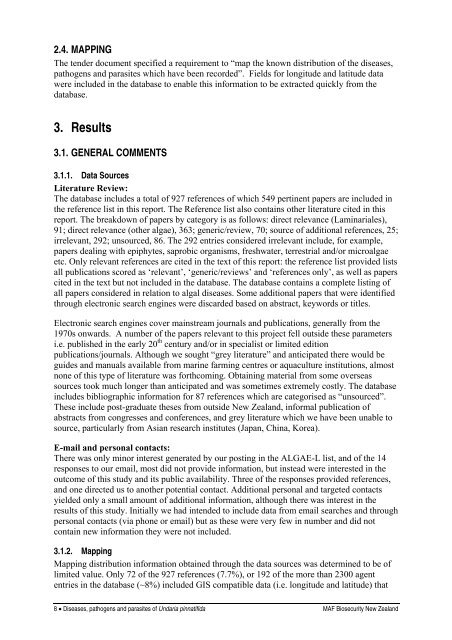Diseases, pathogens and parasites of Undaria pinnatifida
Diseases, pathogens and parasites of Undaria pinnatifida
Diseases, pathogens and parasites of Undaria pinnatifida
Create successful ePaper yourself
Turn your PDF publications into a flip-book with our unique Google optimized e-Paper software.
2.4. MAPPING<br />
The tender document specified a requirement to “map the known distribution <strong>of</strong> the diseases,<br />
<strong>pathogens</strong> <strong>and</strong> <strong>parasites</strong> which have been recorded”. Fields for longitude <strong>and</strong> latitude data<br />
were included in the database to enable this information to be extracted quickly from the<br />
database.<br />
3. Results<br />
3.1. GENERAL COMMENTS<br />
3.1.1. Data Sources<br />
Literature Review:<br />
The database includes a total <strong>of</strong> 927 references <strong>of</strong> which 549 pertinent papers are included in<br />
the reference list in this report. The Reference list also contains other literature cited in this<br />
report. The breakdown <strong>of</strong> papers by category is as follows: direct relevance (Laminariales),<br />
91; direct relevance (other algae), 363; generic/review, 70; source <strong>of</strong> additional references, 25;<br />
irrelevant, 292; unsourced, 86. The 292 entries considered irrelevant include, for example,<br />
papers dealing with epiphytes, saprobic organisms, freshwater, terrestrial <strong>and</strong>/or microalgae<br />
etc. Only relevant references are cited in the text <strong>of</strong> this report: the reference list provided lists<br />
all publications scored as ‘relevant’, ‘generic/reviews’ <strong>and</strong> ‘references only’, as well as papers<br />
cited in the text but not included in the database. The database contains a complete listing <strong>of</strong><br />
all papers considered in relation to algal diseases. Some additional papers that were identified<br />
through electronic search engines were discarded based on abstract, keywords or titles.<br />
Electronic search engines cover mainstream journals <strong>and</strong> publications, generally from the<br />
1970s onwards. A number <strong>of</strong> the papers relevant to this project fell outside these parameters<br />
i.e. published in the early 20 th century <strong>and</strong>/or in specialist or limited edition<br />
publications/journals. Although we sought “grey literature” <strong>and</strong> anticipated there would be<br />
guides <strong>and</strong> manuals available from marine farming centres or aquaculture institutions, almost<br />
none <strong>of</strong> this type <strong>of</strong> literature was forthcoming. Obtaining material from some overseas<br />
sources took much longer than anticipated <strong>and</strong> was sometimes extremely costly. The database<br />
includes bibliographic information for 87 references which are categorised as “unsourced”.<br />
These include post-graduate theses from outside New Zeal<strong>and</strong>, informal publication <strong>of</strong><br />
abstracts from congresses <strong>and</strong> conferences, <strong>and</strong> grey literature which we have been unable to<br />
source, particularly from Asian research institutes (Japan, China, Korea).<br />
E-mail <strong>and</strong> personal contacts:<br />
There was only minor interest generated by our posting in the ALGAE-L list, <strong>and</strong> <strong>of</strong> the 14<br />
responses to our email, most did not provide information, but instead were interested in the<br />
outcome <strong>of</strong> this study <strong>and</strong> its public availability. Three <strong>of</strong> the responses provided references,<br />
<strong>and</strong> one directed us to another potential contact. Additional personal <strong>and</strong> targeted contacts<br />
yielded only a small amount <strong>of</strong> additional information, although there was interest in the<br />
results <strong>of</strong> this study. Initially we had intended to include data from email searches <strong>and</strong> through<br />
personal contacts (via phone or email) but as these were very few in number <strong>and</strong> did not<br />
contain new information they were not included.<br />
3.1.2. Mapping<br />
Mapping distribution information obtained through the data sources was determined to be <strong>of</strong><br />
limited value. Only 72 <strong>of</strong> the 927 references (7.7%), or 192 <strong>of</strong> the more than 2300 agent<br />
entries in the database (~8%) included GIS compatible data (i.e. longitude <strong>and</strong> latitude) that<br />
8 • <strong>Diseases</strong>, <strong>pathogens</strong> <strong>and</strong> <strong>parasites</strong> <strong>of</strong> <strong>Undaria</strong> <strong>pinnatifida</strong> MAF Biosecurity New Zeal<strong>and</strong>

















